6th Airborne Division:
How effective was its contribution to the success of the D-Day landings in Normandy 1944?
Malcolm A. Clough
D-Day Tours of Normandy
A dissertation, posted in seven parts (plus appendices)
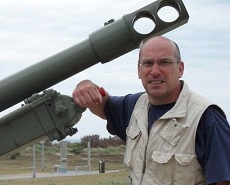
Part 1: Introduction
Part 2: The Development of British Airborne Forces
Part 3: The Arms and Equipment of British Airborne Forces
Part 4: The Importance of Fire Support provided to 6th Airborne
Part 5: Planning and preparation for D-Day
Part 6: The Actions and Outcomes of 6th Airborne’s Operations
Part 7: Conclusions
.
.
6th Airborne Division:
How effective was its contribution to the success of the D-Day landings in Normandy 1944?
Malcolm A. Clough
Part 1: Introduction
The allied invasion of Normandy (Operation Overlord) in June 1944 is perhaps one of the most famous battles in the western theatre of the Second World War. Max Hastings (1984:11) describes it as ‘the decisive western battle of the Second World War, the last moment at which the German army might conceivably have saved Hitler from catastrophe.’ In historical terms the significance of this decisive battle is summed up by Lloyd Clark. (2004:8) ‘When it was won it changed the world forever. The price was high, but for anybody who values the principles of freedom and democracy, it is difficult to conclude that it was one not worth paying.’ While Stephen Chicken (1993: xix) explains the widespread present day interest in the battle It ‘was the largest all-arms conventional battle that the world has seen, or is indeed likely to see. It is therefore not surprising that it continues to fire the interest of people of all ages and from all over the world.
The purpose of this dissertation is to examine the contribution of 6th Airborne Division towards the success of the D- Day landings on 6th June 1944 through the perilous first 24hrs of the invasion until D-Day +6 on 12th June, when the Allied left flank was finally secured. An operation described by Sir Winston Churchill as ‘much the greatest thing we have ever attempted’ (Hastings, 1984:22) The British and American airborne divisions were given the task to shield the flanks of the Allied armies during the seaborne landings and the subsequent creation of a bridgehead in preparation of a break-out.
In his book, Major General Julian Thompson R.M. explains the role given to 6th Airborne. ‘He (Montgomery) was worried that the German armour on his left flank…might win through to the beachhead and roll up his assault divisions. He selected the River Orne and the Caen canal as his anti armour obstacles… 6th Airborne would stake-out the high ground to the east of the Orne to buttress the twin water obstacles’ (Thompson, 1989:130) To impose the maximum delay on the enemy, five bridges over the River Dives between Troan and the mouth of the River Dives were to be destroyed along with a battery of guns in concrete casemates at Merville which would be destroyed half an hour before first light to prevent it firing on the beaches.’
It is my intention to demonstrate how 6th Airborne carried out its allotted tasks for the D-day landings in the face of adversity. Certainly the operation did not go according to plan. Chaos and confusion forced the paratroopers to ‘adapt, improvise and overcome’ inevitable problems to achieve their objectives. Improvisation was a primary consideration for airborne operations according to Fowler ‘Wind, poor navigation and enemy flak caused the paratroopers and gliders to be scattered over a wide area. The pilots had confused the rivers Orne and Dives and over half the battalion landed well to the south and east of their drop zones.’(Fowler, 2003:98) By H-Hour the attacking force which should have been 635 men strong stood at only 150. Despite this significant shortage of numbers and led by Lt. Colonel Otway this ad hoc company ‘in a triumph of courage and improvisation’ (ibid) assaulted and neutralised its objective.
Between Ranville and Sallenelles. 6 June 1944
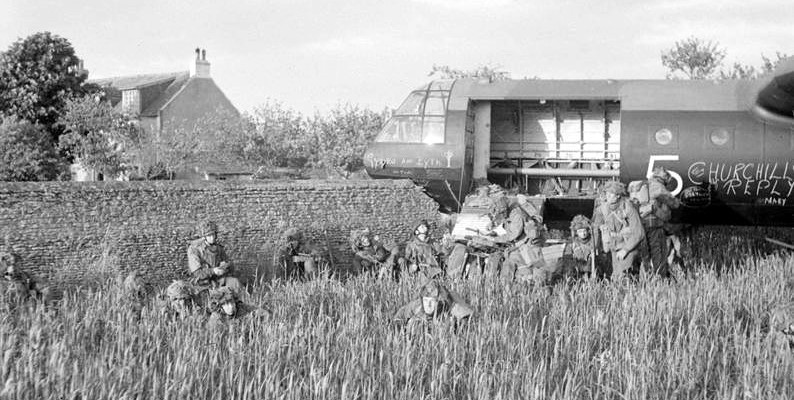
6th Airborne Division: D-DAY 6 JUNE 1944. Glider troops of 6th Airborne Division beside their Horsa glider, which crashed through a stone wall on landing near La Haute Ecarde on the western end of DZ ‘N’ between Ranville and Sallenelles, 6th June 1944.
Airborne warfare has one of the shortest histories of any kind of warfare, being directly linked to the evolution of aviation. It only came into use during the 20th century after the beginning of the 2nd World War. Few military operations have had such a dramatic impact as ‘that of a highly trained yet immensely vulnerable division, dropping from the sky behind enemy lines to assist in the efforts of an enormous amphibious operation to initiate an immensely important campaign.’ (Clark, 2004:15) The use of U.S. 173rd Airborne Brigade during the invasion of Iraq in 2003 illustrates Weeks’ point that although airborne warfare ‘is still very much a potent method of fighting it is unlikely to ever again to reach the intensity of the closing years of the war.’ (Weeks, 1982:8)
Mounting an airborne operation ‘is a highly skilled and demanding craft. It only comes after application and experience. It is not something that is instantly picked up nor is it always obvious,’ (Weeks, 1982:11) The use of airborne forces during the Normandy landings of June 1944 reflects these experiences where, despite thorough planning being disrupted by adversity, the paratroops overcame their difficulties and achieved their objectives to protect the invasion.
Synchronise Watches!
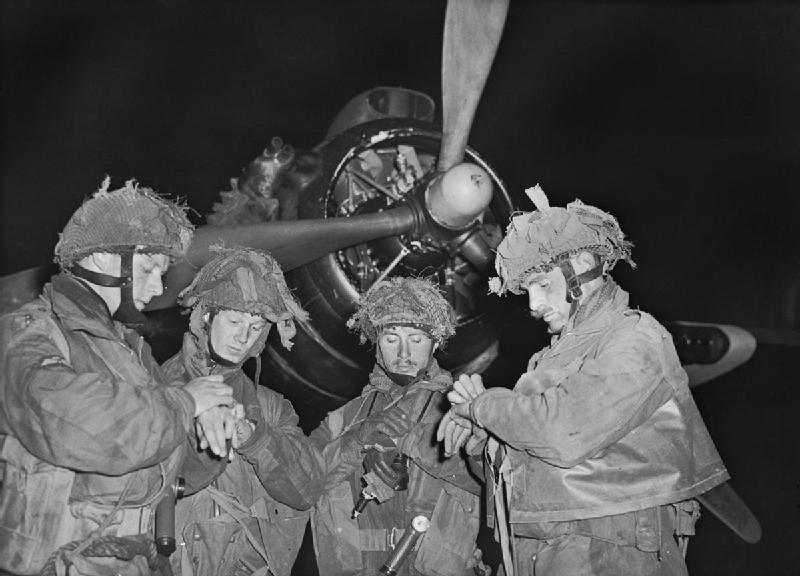
6th Airborne Division: D-DAY 6 JUNE 1944. The Final Embarkation: Four ‘stick’ commanders of 22nd Independent Parachute Company, British 6th Airborne Division, synchronising their watches in front of an Armstrong Whitworth Albemarle of No 38 Group, Royal Air Force, at about 11 pm on 5 June, just prior to take off from RAF Harwell, Oxfordshire. This pathfinder unit parachuted into Normandy in advance of the rest of the division in order to mark out the landing zones, and these officers, left to right, – Lieutenants, Bobby de la Tour Don Wells John Vischer Bob Midwood were among the first Allied troops to land in France. Photo: Imperial War Museum
To understand the role played by 6th Airborne in Normandy I intend to examine how the division came into being, explaining the development of airborne warfare in the 20th Century from the earliest plans of United States Colonel William Mitchell in 1918 to the spectacular successes of German parachutists in the opening years of the Second World and the pyrrhic victory at Crete in May 1941. It is also my intention to study the development of British Airborne forces in particular and demonstrate how they evolved into an elite fighting force of highly trained soldiers learning from combat experience of their German and American counterparts. Great emphasis was placed upon training. General Gale commanding 6th Airborne Division implemented a relentless training programme which created soldiers who were focused on the battle to come. They possessed tremendous levels of physical fitness and endurance which combined with initiative, skill at arms and battle craft made them ‘capable of taking on anyone or anything; to develop the initiative, drive and suspicious alertness which would give the parachute soldier his ability to survive alone or in small groups in a hostile environment.’ (Crookenden, 1976: 46)
In order to carry out my examination of 6th Airborne’s role during the D-day landings, I propose to illustrate the importance of the planning and preparations for the operation, including the intended objectives and to contrast them with actual events.
I shall compare 6th Airborne’s successes and failures with the two American Airborne Divisions which also landed on the western flank in Normandy on D-Day and did not fare any better than the British. ‘The American 82nd and 101st Airborne suffered even more seriously than the British from scattered dropping, and with far more deadly consequences amid the swamps and floods of the Cotentin which drowned hundreds of men before they could even escape their harnesses’ (Hastings,1984,p74)
To achieve a properly balanced assessment it is essential to analyse the landings from the German point of view. Writing in ‘The German Army at D-Day,’ ((2004:179) David Isby, quotes Generalleutant Joseph Reichart dismissing the airborne landings ‘I do not understand why the Allies made the airborne landing prior to the invasion from the sea, because the place of airborne landings was too near the coast for a feint, thereby neutralizing (sic) the element of surprise.’
I intend to show how extremely well trained soldiers succeeded in their mission to protect the seaborne landings. ‘The bulk of 6th Airborne struggled through the darkness and the first hours of daylight to concentrate its units, dispose of German patrols and strong-points and create a firm perimeter east of the Orne from which to resist powerful counter attacks that would inevitably follow’ (Hastings, 1984:74)
Such challenges may well go some way towards explaining why airborne warfare is so fascinating, but they also reveal why an airborne operation should not be considered unless the military circumstances absolutely demand it. Was the deployment of the Airborne Divisions on D-Day really necessary or could their objectives have been achieved by less costly and extravagant seaborne forces?
Were the airborne objectives ‘a critical operational requirement with no alternative means to achieve them?’ (Clark, 2004:16) Or as Max Hastings argues did ‘The airborne operations of D-Day emphasize painfully for the Allies the cost and difficulty inseparable from massed drops even before paratroopers could engage the enemy, and the limitations of lightly armed formations without armoured support?’ (Hastings, 1984:74)
To research this dissertation I have used a variety of reference works. In particular I have made use of established publications by veterans of the campaign e.g. Lt General Napier Crookenden’s book ‘Drop Zone Normandy’ (1976). Crookenden, a Brigade Major at the time of D-Day, took part in the planning of the operation. Major John Howard who led the capture of the bridges over the Caen Canal and River Orne, is perhaps the most famous veteran of the airborne landings, his experiences are recorded in his own personal papers ‘The Pegasus Diaries’ (2006). While Stephen Ambrose’s book ‘Pegasus Bridge’ (1985), gives a popular account of the battle for the bridges and contains many interviews with combatants who took part.
Although the accounts and memoirs of the veterans are crucial to my research I am aware that they do not reflect the overall strategic view of the battle. I have therefore looked at more objective assessments from historians and more recent works which are privy to details not available in the post-war era, e.g. Neil Barber’s ‘‘The Day the Devils dropped in’ (2002). To bring balance to my research I have considered works by those historians who are critical of the British contribution towards D-Day, e.g. Max Hastings who in his work ‘Overlord, D-Day and the Battle for Normandy’ (1984:11) writes ‘Even 40 yrs after the battle, it is astonishing how many books have been published which merely reflect comfortable chauvinistic legends, and how few which seek frankly to examine the record.’
Personal visits to the Battlefield of Normandy have provided invaluable research.
Naturally, the countryside of Normandy has changed during the 60 years since the invasion, in particular the thick hedgerows which were such obstacles in 1944 have been cleared and the artificially flooded areas drained. However, crucial natural features and strong points e.g. The Caen Canal, River Orne and The Merville Battery remain.
I have visited and studied the topography of the ground which helped me to understand the difficulties encountered by the airborne operation in trying to drop soldiers in darkness onto the correct Drop-Zones and Landing Zones. Furthermore how once on the ground, soldiers who were scattered all over the countryside either managed to find their objective or became lost for crucial hours. Mr Mark Worthington, the Curator of the ‘Memorial Pegasus’ at Ranville, during an interview was able to provide a unique insight to a number of important aspects of the campaign. His information is based on his personal contact with many of the veterans.
Watch this space for further chapters!
I intend to publish my entire dissertation on the 6th Airborne division over the coming weeks and months. If you find it interesting, please feel free to link to it. If any readers have any views or additional information, I would be very interested in receiving them so the comment section is open. I look forward to hearing from you.
The next chapter on The Development of British Airborne Forces will be published on January 11th 2020.
Malcolm Cough
D Day Tours of Normandy


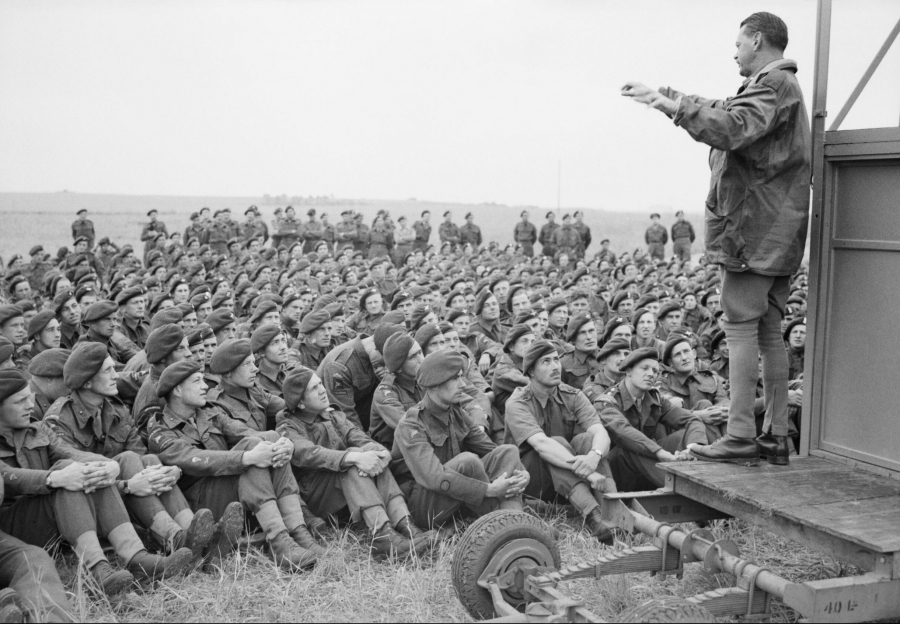
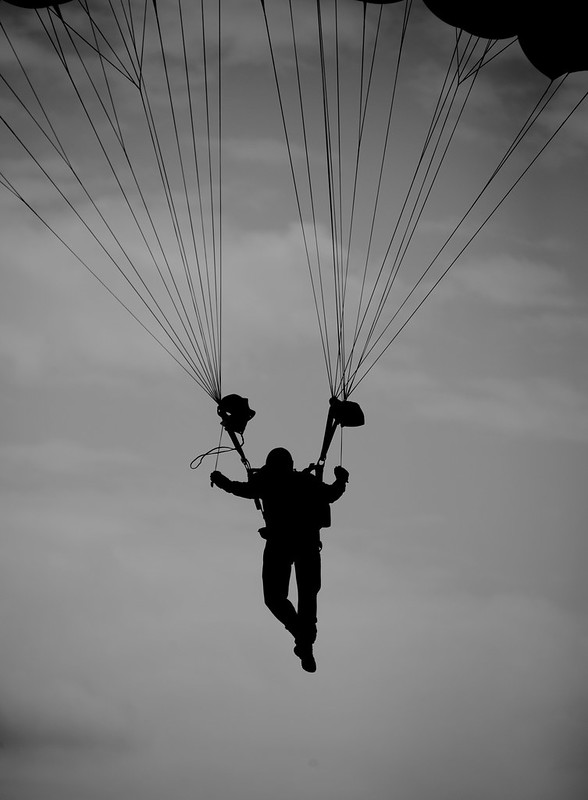
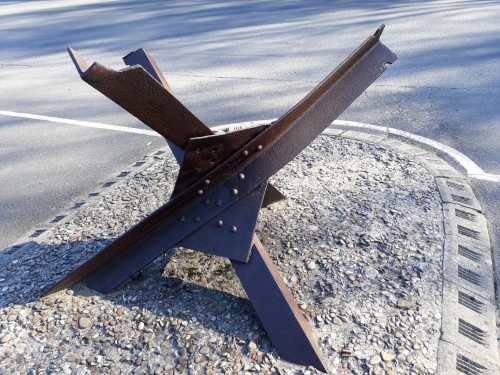
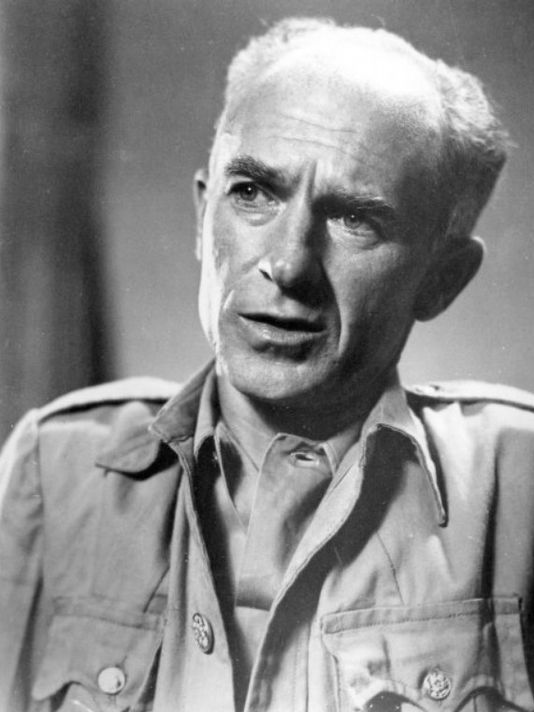
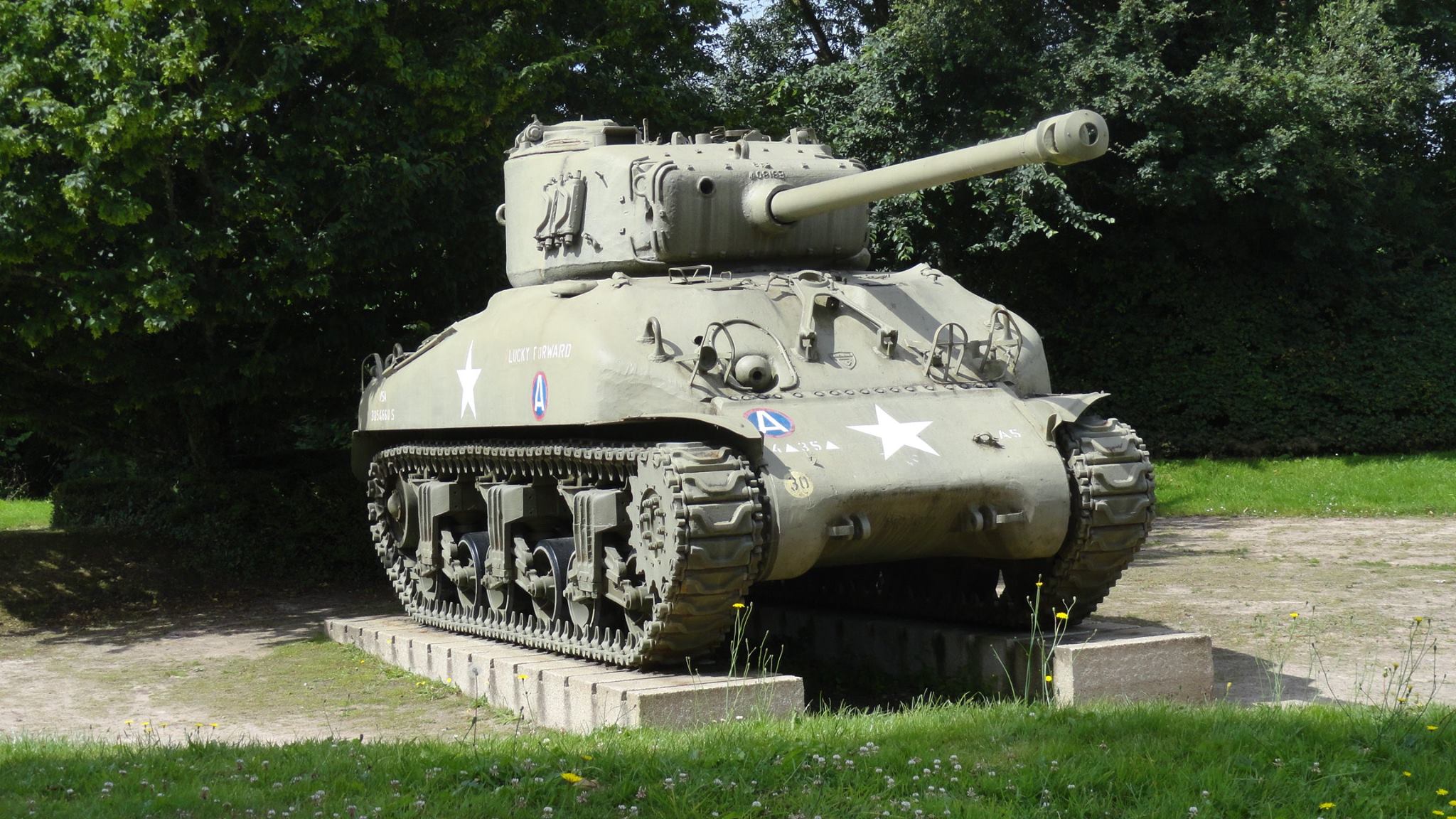
Did pathfinders volunteer for this perilous duty or were they selected by their superiors?